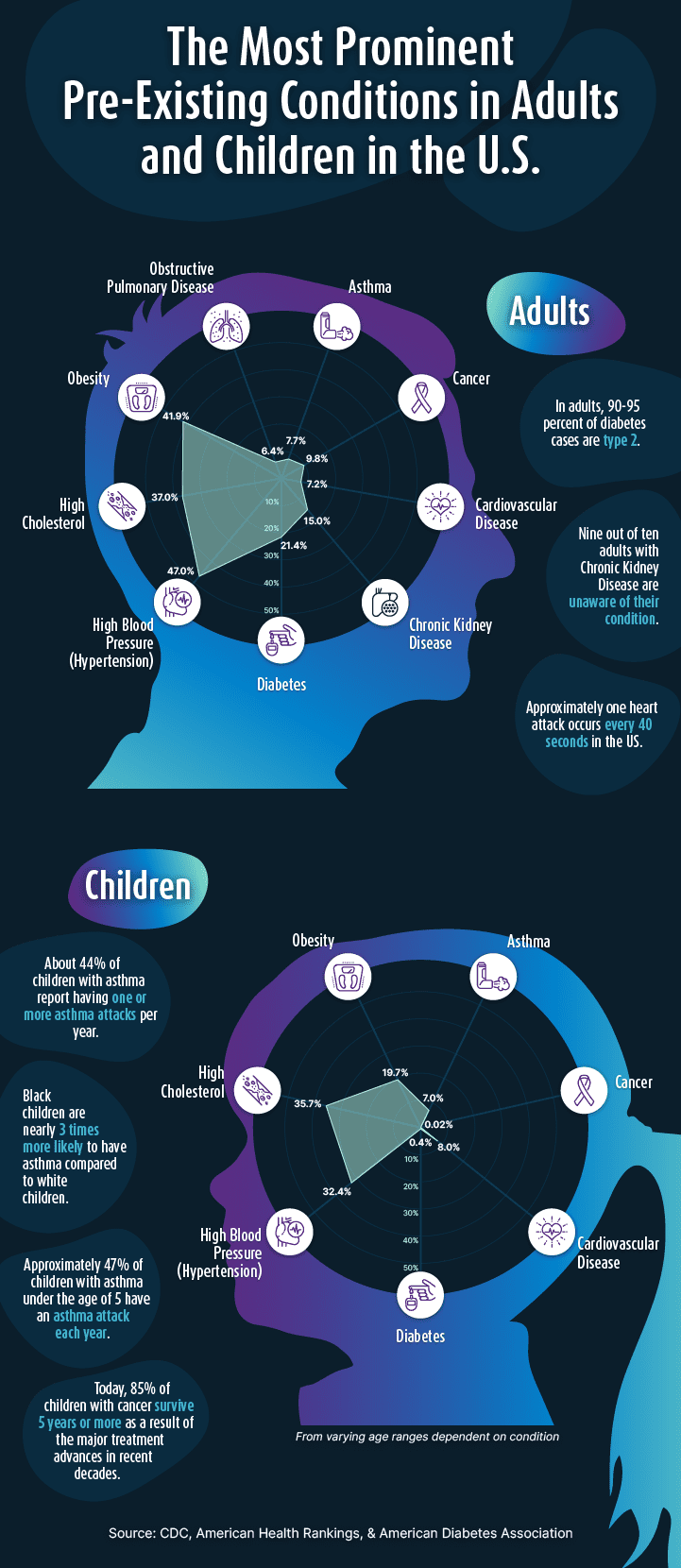Pre-existing conditions, also known as chronic diseases, are long-term health conditions that can significantly impact an individual’s quality of life. In the United States, pre-existing conditions affect a large portion of the population, with a wide range of health outcomes and disparities. We will explore the impact of some of the most urgent pre-existing conditions in the U.S., including HIV, asthma, childhood cancer, heart disease, chronic kidney disease, and diabetes.
For our study, we looked into the major pre-existing health conditions and their prevalence in the U.S. among adults and children. The information was obtained from the Centers for Disease Control and Prevention and leading organizations in each medical field, such as the American Diabetes Association and the American Cancer Society.
Key Findings
- Nearly 1 in 2 (47%) American adults have high blood pressure. It is often referred to as the “silent killer” because it typically has no symptoms, but if left untreated, it can lead to potentially fatal health problems such as heart disease, stroke, and kidney failure.
- Just over 2 in 5 (42%) American adults suffer from obesity. Obesity is defined as having a body mass index (BMI) of 30 or higher and is a risk factor for many chronic health conditions, including heart disease, stroke, type 2 diabetes, and cancer.
- The 3 most prominent pre-existing conditions among children are high cholesterol, high blood pressure, and childhood obesity. They are becoming increasingly common in children and are often related to poor diet and lack of physical activity.
The Most Prominent Pre-Existing Conditions in Adults & Children in the U.S.

Adults Living With Pre-Existing Conditions in the U.S.
In the U.S., heart disease is a public health crisis among adults, with someone having a heart attack every 40 seconds. The statistics are concerning, as 2 out of 10 deaths from coronary artery disease occurred in adults younger than 65 in 2020. This highlights the need for regular heart health check-ups, especially in people with risk factors such as high blood pressure, obesity, and smoking.
Chronic kidney disease is another growing health concern in the U.S. with an estimated 9 out of 10 adults who have the condition not being aware of it. Chronic kidney disease can be caught early on with regular check-ups and testing. Early detection and treatment of chronic kidney disease can prevent serious health problems and improve outcomes for those living with the condition.
Type 2 diabetes is the most common form of diabetes in adults, accounting for between 90-95% of all diagnosed cases. Diabetes affects millions of Americans and is a leading cause of heart disease, stroke, kidney failure, and many other serious health problems. Early detection and management of type 2 diabetes are critical to prevent further complications and improve overall health outcomes for patients as time progresses.
According to a recent estimate, 13% of Americans with HIV do not know they have the virus, further emphasizing the importance of testing and early detection. Regular STI testing can detect the presence of the virus early and allow for prompt treatment to prevent serious health complications and reduce transmission to others. The highest rates of new diagnoses continue to occur in the South, underscoring the need for increased education and access to care in this region.
Pre-Existing Conditions in Children Across the U.S.
Asthma is the leading chronic disease in children, and black children are nearly three times more likely to have asthma than white children. 44% of children with asthma report experiencing at least one attack each year, whereas 40% of adults have one or more asthma attacks annually.
Children under the age of five are particularly susceptible, with 47% of these children having an asthma attack each year. According to Mayo Clinic, risk factors for childhood asthma include family history, exposure to tobacco smoke (including before birth), and previous allergic reactions, including skin reactions, food allergies, or hay fever (allergic rhinitis).
Cancer is perhaps the most devastating childhood illness, but thanks to medical advancements, survival rates have improved significantly over the years. While childhood cancer rates have been rising slightly for the past few decades, they have stabilized since 2010. Thanks to these advances in treatment, 85% of children with cancer now survive for five years or more. This stabilization of rates speaks to the tremendous strides that have been made in the field of pediatric cancer treatment.
Closing Thoughts
Pre-existing conditions can affect an individual’s ability to obtain and maintain an insurance policy. Before the Affordable Care Act (ACA), insurance companies could deny coverage or charge higher premiums to individuals with pre-existing conditions. The ACA aimed to address this issue by prohibiting insurance companies from denying coverage to individuals with pre-existing conditions and charging higher premiums based on their health status.
Americans living with pre-existing health conditions can rely on their health insurance to help cover the costs of frequent visits to the doctor. Assurance IQ can help connect individuals with the right health insurance plans for their situations.
Methodology
We collected data from the below sources to analyze the percent of Americans (adults and children) with pre-existing conditions to determine the most prominent and least prominent conditions across the U.S. In instances where necessary, we used Census population data (number of American adults and number of American children) to calculate the percentages.
Pre-Existing Health Condition | Sources Used |
|---|---|
Asthma | |
Cancer | |
Cardiovascular Diseases | |
Chronic Kidney Disease | |
Chronic Obstructive Pulmonary Disease | |
Diabetes | |
High Blood Pressure / Hypertension | |
High Cholesterol | |
Obesity |
